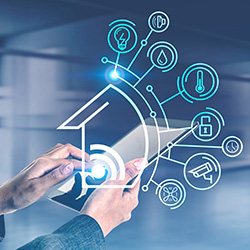 The technology’s nothing new. In fact, Remote Patient Monitoring often referred to as RPM, has been around for a decade.
The technology’s nothing new. In fact, Remote Patient Monitoring often referred to as RPM, has been around for a decade.
The premise behind RPM is relatively simple – it tracks vitals, provides important metrics when patients are away from a medical setting like an office, clinic, or hospital. Various types of RPM programs “collect data using symptom surveys, wearable sensors, and other medical devices and send this information to a healthcare practitioner to facilitate clinical assessment and decision-making.”1 Metrics monitored vary widely – from blood pressure to weight and oxygen saturation.
Want More Tech News? Subscribe to ComputingEdge Newsletter Today!
New York City-based market research firm CB Insights said the worldwide $30 billion + RPM market is poised for further explosive growth; the COVID-19 pandemic has led to a huge surge in demand because of hospital ER rooms filled to capacity with COVID patients and the global lockdowns over the past couple of years.
According to a CB Insights story on 2022 tech trends, healthcare providers like the Mayo Clinic and insurers are now partnering with RPM startups and wearable makers; even non-healthcare industries are coming on board.2
Some examples:3
- AT&T is partnering with Samsung and digital healthcare startup Qure4U on an initiative to monitor people with high blood pressure.
- Salesforce is now offering an RPM tool on its cloud-based platform to help providers manage RPM deployments.
- Best Buy invested $400 million last October and acquired Current Health, a startup providing RPM devices and a data platform. Best Buy plans to turn storefronts into de facto points of care to offering RPM devices to manage the data created.
KLAS Research reported last year that while most RPM initiatives to date have been relatively modest, the technology is making significant inroads and we’ll see even more innovative solutions to help patients over the next few years.
“So far, most RPM programs might have between 25-100 monitoring kits they can use at any one time, usually for very focused use cases,” noted Colin Buckley, KLAS Research director of market analysis. “But most of the organizations we talk to say they’re having success in terms of outcomes, and these successes often happen very quickly.”4
Lastly, Dr. Lucienne Ide, founder of Atlanta, GA-based Rimidi, a cloud-based RPM technology company, added that during the COVID-19 pandemic, RPM has allowed patients to get the care they need while keeping them out of healthcare settings to limit potential exposure to the coronavirus.
And as healthcare further shifts from a fee-for-service to a value-based approach, Lucien said that “care delivery is shifting from an in-clinic, episodic, reactive model of care to one that is continuous and proactive, and a blend of in-clinic and remote. RPM is an effective way to ensure all patients can receive the quality, continuous care their condition requires.”5
Sources
- Sreekar Mantena and Salmaan Keshavjee, PMC: US National Library of Medicine/National Institutes of Health, 7/21/21.
- 12 Tech Trends to Watch Closely in 2022, CB Insights, October 2021.
- Ibid.
- How Remote Patient Monitoring Programs Are Beneficial, Health Tech, 4/27/21.
- The Benefits and Future of Remote Patient Monitoring, Healthcare IT News, 4/12/21.